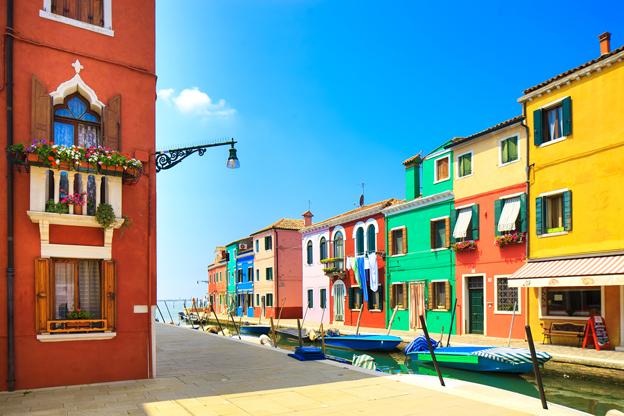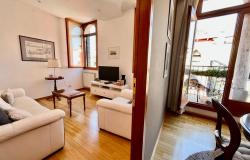It goes without saying that Venice is a must-visit place for any traveller within its proximity, but to my mind it would be unthinkable now to visit this unique place without taking a water bus over to the little island of Burano – the ‘jewel’ in the Venetian crown.
I can remember the first visit to Burano and how I realized at the time that we were in for a treat. It is always exciting to experience new territory, but this had great photographic potential too, so it was going to be a double delight.
We reached by feet the Fondamenta Nuove, on the northern border of Venice, facing the lagoon, and then caught the water bus to Burano. The vaporetto takes just 40 minutes to arrive at the landing stage of the island.
Rainbow Island

Philip and I could not wait for the boat to dock as already we could see the multi-coloured terraced homes, which follow the gentle curves of the narrow canals. The colours are not just beautiful in the distinct light of the region, but they are practical too.
Each one marks the territorial boundary of a property and residents can see their homes from quite a distance, useful for fishermen returning with their catch in the misty morning.
Get there on an early boat and you are almost certain to see the ladies of the island sweeping and wiping down their immaculate house fronts. Little brooms and polishing equipment ‘decorate’ many a façade along with ‘buntings’ of white linen which are draped neatly across homes and the little squares linking the narrow passages. The fogher or hooded fireplace gives interest to the outer shape of many of the walls, whose typical Venetian windows are ‘framed’ with a white band.
From swamps to lace
Archeological evidence has shown that early settlers have inhabited Burano since before the Roman colonization. They were fishermen, salt gatherers and farmers, all well versed in navigation. Burano’s naturally sheltered position and its detachment from the mainland meant these original lagoon dwellers were protected from invaders and plagues of malaria which were normal in the other islands.
Inhabitants over the centuries raised the ground, dug canals and built bridges to transform a swamp into a hospitable place.

The island is approximately seven kilometres from Venice and has always been closely connected to it by its shared past in good and bad times. It was occupied by French and then Austrian troops and contributed its own heroes to the ill-fated 1848 revolution led by Daniele Manin. In 1866, it joined the kingdom of Italy together with the whole of Veneto and became a township of the Municipality of Venice in 1923. It has long been associated with lace, first produced by nuns in the 15th century, and then taken up by fishermen's wives.
Visit the museum and admire the intricate work of these nimble fingered lace-makers or you can browse the little stalls and small shops along the canal paths into the main square, Piazza B. Galuppi, dedicated to a famous Italian musician born in Burano named Baldassare Galuppi (1706-1785).
Tapestries, jewellery, linen and other quality items are on display, but there is no ‘hard sell’ and it is so relaxing to sit with a caffé latte in the one bustling thoroughfare that Burano possesses.
Seafood is another good reason to visit Burano, as there are many excellent restaurants serving typical local dishes mostly centered around the main piazza.
Local Colour

Each time we visit Burano, the local people have played an important part in making the experience a very enjoyable one. A lady bustles past on one of the little wooden bridges and shouts over to a friend who is leaning out of the window, and their laughter resounds from the buildings. An old man passing by in his boat has a conversation with another old man sitting on a step. The voices are amplified by the narrow walls and waterways and it makes it all feel special. A monk in long brown robes passes the central church of San Martino, which has a tower leaning like the famous Pisa one.
The church was constructed in the 16th century with three aisles, transept, major chapel and two side chapels with an arched ceiling supported by pillars. The most important work of art in the church is the 1727 Tiepolo's Crocifissione.
We ask a lady who is pinning out laundry through her window if we can photograph her with peg in hand leaning over the pristine, sweet smelling linen and she obliges with a warm smile, holding that peg whilst we get ‘just one more shot please’.
Even after capturing a couple of hundred images of Burano, it is impossible to stop. I cannot get enough of this little island.
Happy Memories

I once read that, around 1921, there was a plan to link the mainland to Venice with an iron street going as far as the Fondamenta Nuove and then a separate causeway to S. Erasmo, S. Francesco del Deserto and on to Burano. Another project suggested a suspended railway could connect Mestre to the Cavallino, with branches to Murano and Burano. Even more incredible was the idea of connecting the islands with a sub-lagoon metro system!
Fortunately none of the ideas got under or off the ground. Burano stands in pleasant isolation, a unique little gem of the Venetian lagoon and long may it remain so.
All too soon it is time to leave and we make our way slowly to the waterbus, which always seems to be arriving in the little dock just as we are. The colours, leaning tower and the San Martino Cathedral fade into the distance, but we have the photos, the memories of a wonderful day in Burano and the thought that it won't be too long before we will be back in this beautiful place again, with camera at the ready of course.














